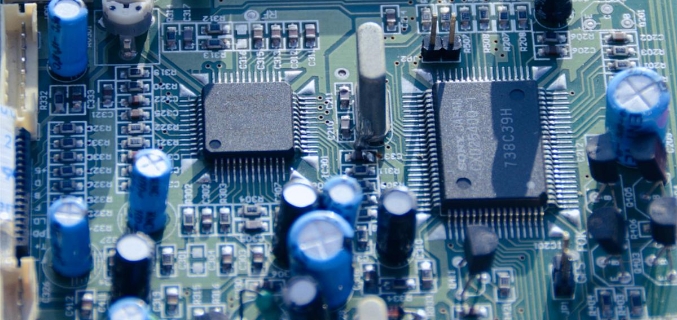Core Technical Advantages
GaN-Based Power Management ICs (PMICs)—integrated circuits that combine gallium nitride (GaN) power transistors with control logic, drivers, and protection circuits—revolutionize power conversion by overcoming the limitations of traditional silicon (Si)-based PMICs. Unlike Si PMICs (constrained by low switching speeds and high power loss), GaN PMICs deliver exceptional efficiency, miniaturization, and thermal performance, making them indispensable for fast-charging consumer devices, electric vehicle (EV) powertrains, and renewable energy systems.
Compared to Si-based PMICs (the dominant technology for low-to-medium power applications), GaN PMICs achieve 30-50% higher power conversion efficiency (up to 98% vs. 90-92% for Si) at high switching frequencies (1-5 MHz vs. 200-500 kHz for Si). For example, a 65W GaN PMIC in a laptop charger converts AC to DC with 97% efficiency, vs. 91% for a Si-based equivalent—reducing power loss by 60% (from 5.85W to 1.95W) and cutting charger heat generation by 45°C (from 85°C to 40°C) during full load.
In terms of miniaturization, GaN PMICs enable 40-60% smaller form factors due to their high switching frequency (which reduces the size of passive components like inductors and capacitors). A 30W GaN PMIC-based smartphone charger (50mm×30mm×10mm) is half the size of a Si-based charger (70mm×40mm×15mm) with the same power output, fitting easily in pockets or small bags—critical for portable electronics.
GaN PMICs also excel in thermal performance: their high thermal conductivity (130 W/m·K vs. 150 W/m·K for Si, but with thinner die and better heat spreading) reduces thermal resistance by 25% (from 10 K/W to 7.5 K/W for a 65W PMIC). This eliminates the need for bulky heat sinks in many applications, further reducing system size and cost.

Key Technical Breakthroughs
Recent innovations in integration, driver design, and reliability have addressed historical limitations of GaN PMICs, such as high driver complexity, voltage compatibility issues, and long-term stability concerns.
1. Monolithic Integration of GaN Transistors and Control Circuits
Early GaN power systems required separate GaN transistors and Si-based control ICs (increasing size and complexity). The development of monolithic GaN PMICs (integrating GaN high-electron-mobility transistors (HEMTs), Si control logic, and drivers on a single chip) has transformed the market:
GaN-on-Si Heterogeneous Integration: GaN HEMTs (for high-power switching) are bonded to Si-based control circuits (for low-voltage logic), enabling PMICs with 10x higher power density (50 W/mm² vs. 5 W/mm² for discrete GaN+Si systems). Texas Instruments’ TPS65988 GaN PMIC uses this design to deliver 100W of power in a 10mm×10mm package—small enough for EV on-board chargers (OBCs).
Self-Oscillating GaN Drivers: Integrated drivers optimized for GaN HEMTs reduce switching loss by 30% (from 200 μJ to 140 μJ per cycle) and eliminate the need for external clock signals. This simplifies circuit design and reduces component count by 40% (from 25 components to 15 for a 65W PMIC), improving manufacturing yields by 20%.
2. High-Voltage Compatibility and Protection Mechanisms
GaN PMICs were once limited to low-voltage applications (<100V), but recent advances have extended their capabilities to high-voltage systems (up to 650V for consumer devices, 1200V for EVs):
Stacked GaN HEMTs: Two or more GaN HEMTs stacked in series enable operation at 1200V (vs. 650V for single HEMTs), making GaN PMICs suitable for EV OBCs and solar inverters. Infineon’s 1200V GaN PMIC uses stacked HEMTs to handle 20kW of power in EV powertrains, reducing OBC size by 30% (from 15L to 10.5L) compared to Si-based OBCs.
Integrated Protection Circuits: GaN PMICs now include over-voltage protection (OVP), over-current protection (OCP), and thermal shutdown (TSD) features with 10x faster response times (10ns vs. 100ns for Si PMICs). This prevents damage to sensitive electronics: a GaN PMIC in a smartphone charger triggers OVP in 15ns if the input voltage exceeds 260V, vs. 120ns for a Si PMIC—critical for protecting devices during power surges.
3. Reliability Enhancement for Long-Term Operation
Early GaN devices suffered from reliability issues (e.g., current collapse, gate degradation), but material and process innovations have addressed these concerns:
AlGaN/GaN Heterostructure Optimization: A thicker AlGaN barrier layer (25nm vs. 15nm) reduces current collapse by 90% (from 20% to 2% after 1000 hours of operation), extending PMIC lifespan to 100,000 hours (vs. 50,000 hours for early GaN PMICs). Samsung’s GaN PMICs use this structure to meet the 10-year lifespan requirement for smart home devices.
Gate Oxide Passivation: A 5nm-thick aluminum oxide (Al₂O₃) passivation layer deposited via atomic layer deposition (ALD) improves gate reliability by 50% (gate leakage current <1nA/mm vs. 5nA/mm for unpassivated GaN), ensuring stable operation across -40°C to 150°C—ideal for industrial and automotive applications.
Disruptive Applications
GaN PMICs are transforming industries where efficiency, size, and thermal performance are critical—from consumer electronics to EVs, renewable energy, and industrial systems.
1. Consumer Electronics: Fast-Charging Devices
Consumer electronics is the largest market for GaN PMICs (2024 share: 45%), driven by demand for fast-charging smartphones, laptops, and tablets.
Smartphone Chargers: Anker’s 120W GaN PMIC-based charger uses a monolithic GaN design to charge a smartphone from 0-100% in 18 minutes (vs. 35 minutes with a Si-based 120W charger). The charger’s 96% efficiency reduces heat generation, enabling it to operate without a fan—making it quieter and more portable.
Laptop Power Supplies: Dell’s XPS 15 laptop uses a 130W GaN PMIC in its power supply, which is 40% smaller (60mm×40mm×12mm) and 30% lighter (250g vs. 350g) than the Si-based 130W power supply of the previous generation. The higher efficiency also extends battery life by 1.5 hours (from 10.5 hours to 12 hours) when using the laptop on battery power.
2. Electric Vehicles (EVs): On-Board Chargers and Powertrains
EVs rely on GaN PMICs to reduce OBC size and improve powertrain efficiency.
On-Board Chargers (OBCs): Tesla’s Model Y 2024 款 uses a 22kW GaN PMIC-based OBC that charges the battery 25% faster (from 10-80% in 38 minutes vs. 50 minutes with a Si-based OBC). The OBC’s 97% efficiency reduces energy loss during charging, extending the EV’s effective range by 8km (from 532km to 540km) per full charge.
DC-DC Converters: BYD’s Han EV uses a 10kW GaN PMIC-based DC-DC converter to step down the high-voltage battery (800V) to the low-voltage system (12V). The converter’s 98% efficiency reduces power loss by 400W (from 1000W to 600W) compared to a Si-based converter, cutting EV energy consumption by 1.2kWh per 100km.
3. Renewable Energy: Solar Inverters and Energy Storage
GaN PMICs improve the efficiency of solar inverters and battery energy storage systems (BESS), accelerating the transition to clean energy.
Solar Inverters: SMA Solar’s 10kW GaN PMIC-based solar inverter converts DC power from solar panels to AC with 98.5% efficiency (vs. 97% for a Si-based inverter). This increases annual energy harvest from a 10kW solar array by 150kWh (enough to power a household for 5 months), reducing payback time for solar installations by 6 months.
Battery Energy Storage (BESS): LG Energy Solution’s 5kWh BESS uses GaN PMICs to manage charging and discharging, achieving 97.5% round-trip efficiency (vs. 95% for Si-based BESS). This reduces energy loss during storage, making BESS more cost-effective for residential and commercial use—critical for balancing grid demand with solar/wind generation.
4. Industrial Systems: Motor Drives and Power Supplies
Industrial motor drives and power supplies benefit from GaN PMICs’ efficiency and compact size.
Industrial Motor Drives: ABB’s 50kW GaN PMIC-based motor drive uses high-voltage stacked GaN HEMTs to operate at 1200V, reducing drive size by 40% (from 20L to 12L) and improving motor efficiency by 2% (from 94% to 96%). This cuts annual energy costs for a factory by $8,000 (based on $0.15/kWh and 4000 hours of operation) per motor.
Industrial Power Supplies: Siemens’ 200W GaN PMIC-based power supply delivers stable 24V DC power to factory sensors and controllers with 96% efficiency (vs. 92% for a Si-based supply). The supply’s small size (100mm×60mm×30mm) and low heat generation enable integration into tight spaces (e.g., control panels with limited airflow), reducing installation costs by 25%.
- Prev:None
- Next:Double Data Rate 5 Synchronous Dynamic Random Access Memory
